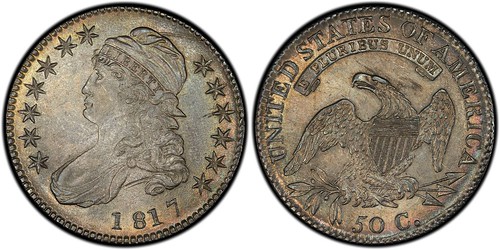
PREV ARTICLE
NEXT ARTICLE
FULL ISSUE
PREV FULL ISSUE
MORE ON DIE VARIETIESRegarding his question about the definition of coin varieties, Bill Eckberg wrote:
"Reading these replies, I realize that I didn't phrase my question very well. What I was trying to get at was, how much difference is required between two coins before we say they were struck from different dies?"
Brad Karoleff writes: "If the die itself, the hunk of steel with the design on it, is the same it is the original die MARRIAGE. If it is extensively reworked it is still the SAME die but now in a different STATE or STAGE making the coins minted from it a die STATE or STAGE of the original die MARRIAGE. "Let's use the 1817 half dollars as an example. We have the Overton 103, the punctuated date, which shows a distinct dot between the 1 and 7. In later die states it disappears. It is still the same marriage of O103, but a different state which does not show the dot (O103a). "We can also look at the O106. In the earliest die state the marriage comes with the ridge from the top of the cap to the rim on the obverse and a normal reverse. After use the reverse die was severely lapped removing the upper leaf from the olive stem on the reverse creating the single leaf VARIETY. It is still the same MARRIAGE but in a distinct different STATE or STAGE that is highly collected by specialists (O106a single leaf). " Bill and I like this description. Next up is an additional commentary by John Regitko of Toronto, Canada on what DOESN'T constitute a variety. -Editor With reference to what is a variety and what is an error, I accumulated many contradictions and errors for my Error & Variety Seminars that dominate the "informational" websites on the Internet. Here are a few examples: The Coins of the Year Club (COTY) of Saskatoon, Saskatchewan, published the following: "Error coins are usually a result of a worn out die or a sudden break in a die. Many people think because a coin has grease or nicks in the coin that it is an error. There are many types of errors but you must think of it in terms of rarity, not appearance. The rarest errors are errors that are very difficult to identify, such as the 7 over 8; double mint mark; or double dies." I don't know about you, but I never had difficulty identifying 7 over 8, double mint marks or double dies. And I never thought that rarity determined what the error is. COTY also published the following: "Things like dings, marks or "cuds" as they are known are very common and would never be considered an error by any standard, especially when produced by the millions." Millions of cuds and dings or marks on a die would indeed be very common! The Coin Community Forum carried on a discussion about die axis. The Charlton Standard Catalogue of Canadian Coins lists the axis of the Canadian 1992 New Brunswick commemorative quarter two arrows up (normal medallic setup), one arrow up and one down (error 180 degree die rotation set-up), and one arrow up and one sideways (error 90 degree rotation). To the question from one of their members if these are errors, the response is: "Yes, but the error is so plentiful, it is termed a variety." I never thought that the number available of a particular inconsistency from normal determines if something is an error or a variety! Hans Zoell's explanation of why we should not blame the equipment for producing errors would be laughable if he was not serious. Zoel published a number of booklets in the 1960s containing illustrations of errors and varieties with very minimal explanation. One rant he published in one of his booklets, under the heading "What is an Error?," stated: "Errors, in reality, are the result of human carelessness, and can not be attributed directly to mechanical malfunction. A machine does not have a brain, and will function only as efficient as the human attendant will care for it. If the attendant or operator does not take proper care of the machine he operates, or faulty parts are contained within, a machine will not function well and is bound to produce faulty products. Therefore we must attribute ‘errors' to ‘human' carelessness and not to the machine, directly." Zoell's unique reasoning is: "Would you be able to correct the faults by giving a machine a ‘good talking to' to make it understand its wrong doings? I guess not. Why then blame a machine for inefficient production?" Huh? With such misinformation out there, no wonder that many collectors have a problem deciding what is an error and what is a variety! I found the best simple explanation on minterrornews.com about the difference between a variety and error because it included exceptions. For example, although die cracks and brockages could appear on hundreds of coins, there are generally minute differences between strikes due to expansion of the die crack or flattening of the design and are therefore considered errors, not die varieties. Thanks, everyone. -Editor
To read the earlier E-Sylum article, see:
Wayne Homren, Editor The Numismatic Bibliomania Society is a non-profit organization promoting numismatic literature. See our web site at coinbooks.org. To submit items for publication in The E-Sylum, write to the Editor at this address: whomren@gmail.com To subscribe go to: https://my.binhost.com/lists/listinfo/esylum All Rights Reserved. NBS Home Page Contact the NBS webmaster 
|

